
Copyright: Knut Lundmark, Lund Observatory.
 Copyright © Michael Richmond.
This work is licensed under a Creative Commons License.
Copyright © Michael Richmond.
This work is licensed under a Creative Commons License.
If we go outside at night and look up at the sky, we see little pinpoints of light floating in what appears to be empty space.

Copyright: Knut Lundmark, Lund Observatory.
However, our eyes can detect only visible light. If we look at the sky at longer wavelengths, we get a very different impression. Click on the picture below to see the sky through different eyes.

Copyright: Knut Lundmark, Lund Observatory.
In fact, the space between the stars is NOT empty. Giant clouds of gas and dust are scattered throughout our galaxy. If we look carefully, we can even see them in ordinary photographs take in the optical:
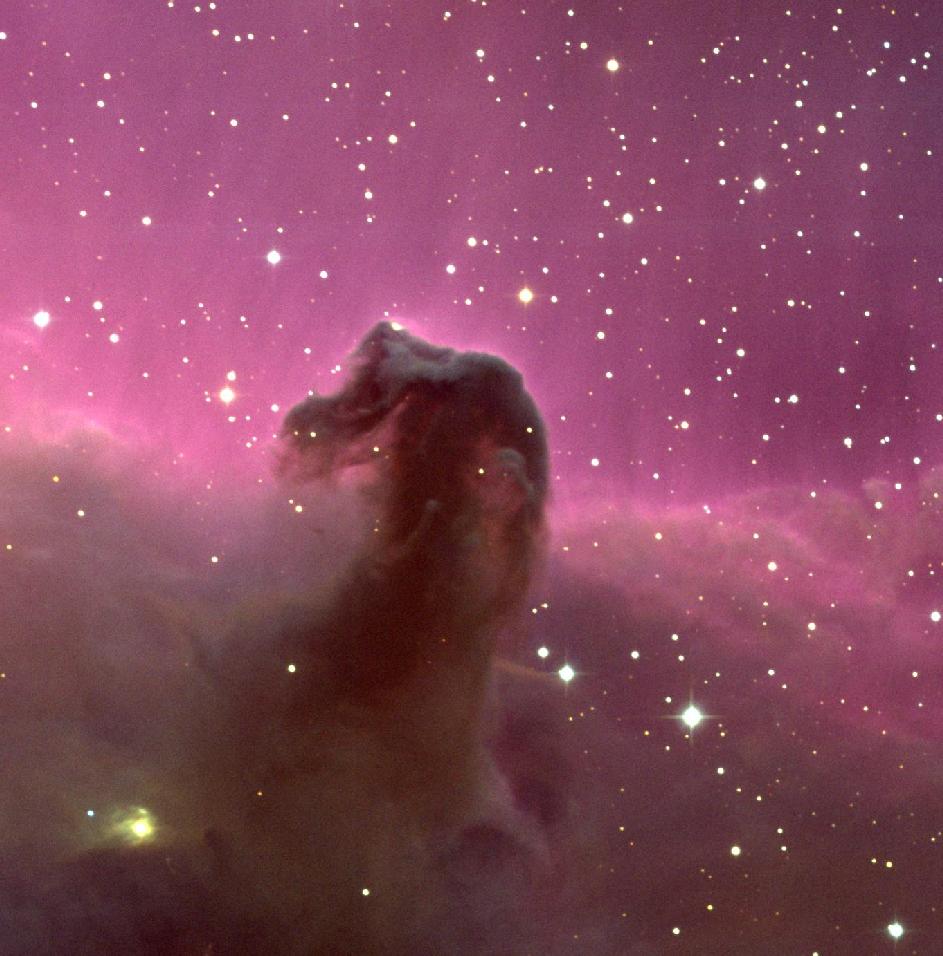
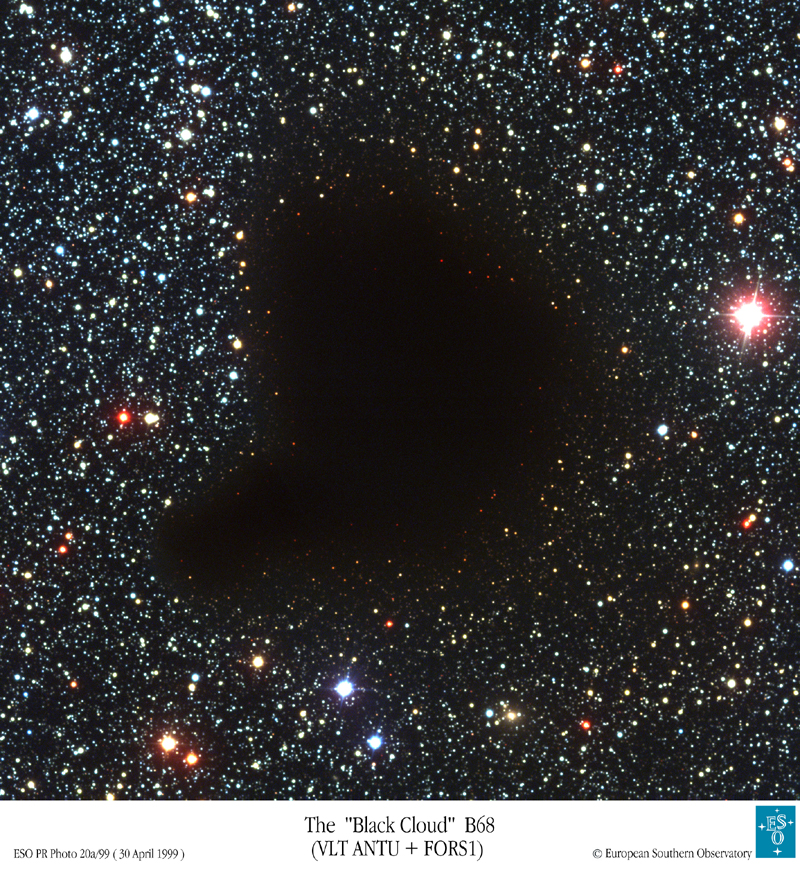
Q: Why are the stars near the edges
of this dark cloud reddish?
Stars are very hot: their typical temperatures run from about 3000 K to about 20,000 K. That means that most of their light appears in the optical portion of the electromagnetic spectrum. Clouds of gas and dust, on the other hand, are often isolated far from any source of radiation. They can cool down to temperatures of just 100, or 50, or even 20 Kelvin.
Q: Suppose a cloud has a temperature
T = 20 Kelvin. At what wavelength
does its radiation reach a peak?
If you are interested in studying these cool clouds of gas and dust, the best sort of instruments are radio telescopes.
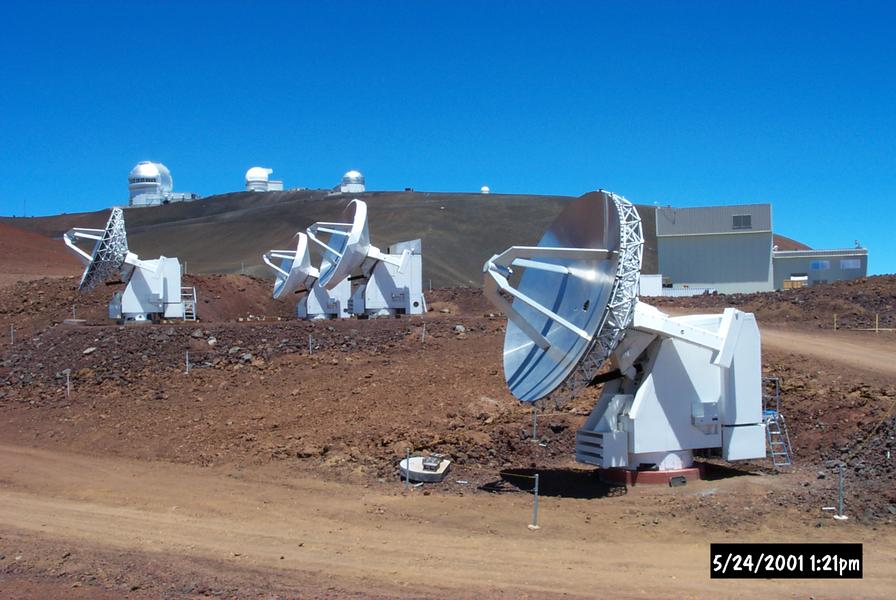
One of the advantages of using radio telescopes is that, at these very long wavelengths, radiation passes easily through even the thickest clouds of dust. With radio telescopes, and to a lesser extent with infrared telescopes, we can peer through the shrouds of dust and see into the very center of a cloud.
Over the past fifty years, astronomers have found several different types of cloud in the InterStellar Medium (or ISM for short).
Component Temperature Density State
(K) (atoms/cm^3)
----------------------------------------------------------------------------
HI clouds 50 - 100 1 - 10^3 neutral atoms
Molecular clouds 20 - 50 10^3 - 10^5 molecules
WIM 10^3 - 10^4 0.01 partially ionized
HII regions 10^4 10^2 - 10^4 mostly ionized
Coronal gas 10^5 - 10^6 10^(-4) - 10^(-3) fully ionized
-----------------------------------------------------------------------------
The coldest, densest type, known as molecular clouds or giant molecular clouds, is the type that gives rise to new stars. Let's take a closer look ....
Using tracers such as dust grains and CO molecules, astronomers have studied giant molecular clouds for several decades. We know the characteristics of a typical molecular cloud pretty well: it is very large (containing several hundred thousand solar masses of material) and very cold (only about 10 K). The gas within has a density of over 1,000 molecules per cubic centimeter, much higher than the average in interstellar space. The combination of high density and low temperature means that any clumps which may form within the cloud are liable to start collapsing under their own self-gravity. Indeed, when we look closely at molecular clouds, we find that they are full of such clumps, often called "cores"; and within the cores, new stars are being born.
One nearby molecular cloud lies with the boundaries of the constellation Taurus, just above the upper horn of the Bull.
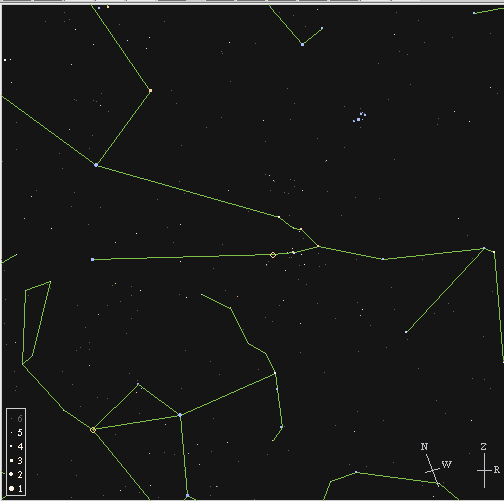
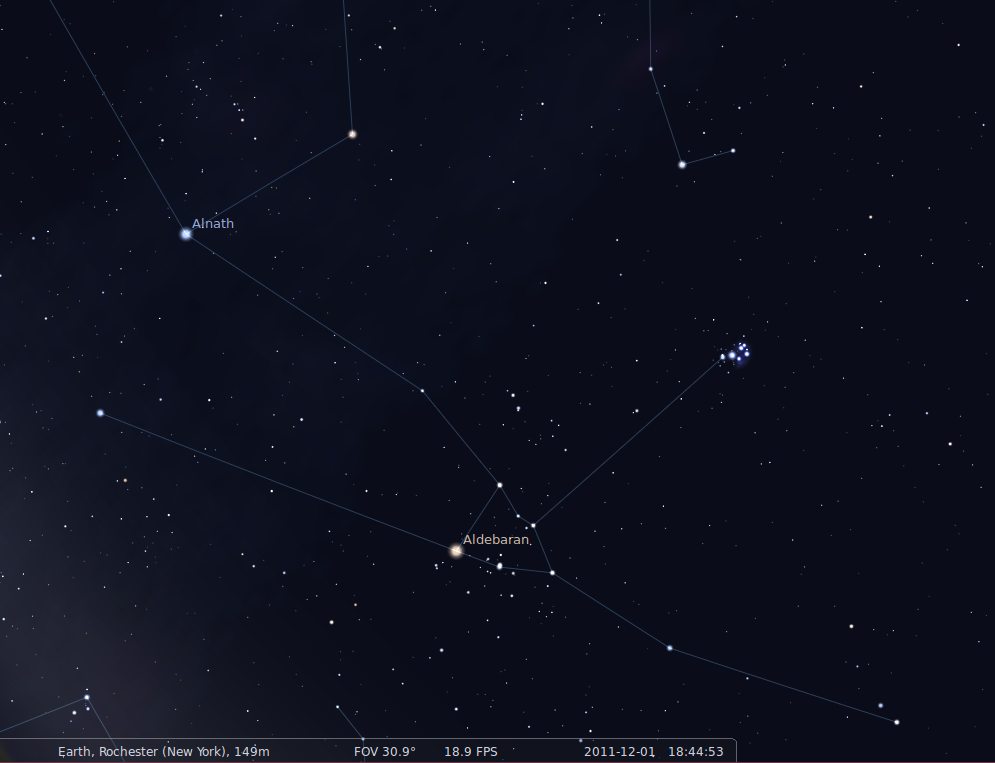
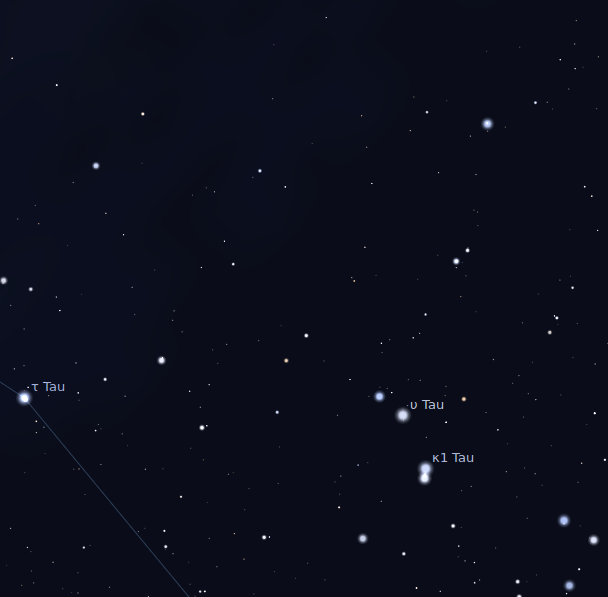
In this 6x6-degree optical photograph, the area looks rather empty.
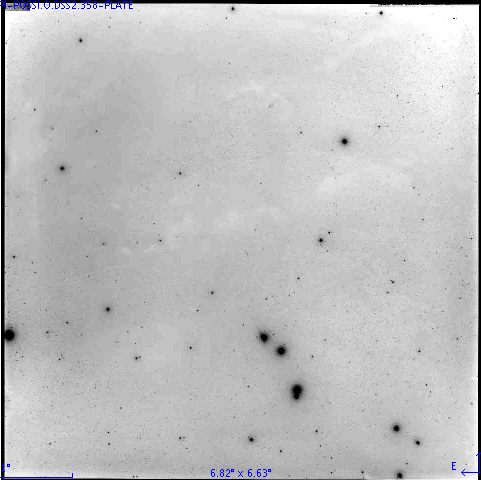
But in the far-infrared, we see diffuse emission from dust all over the place. This entire area is part of a giant molecular cloud. There are several dense cores of infrared emission ...
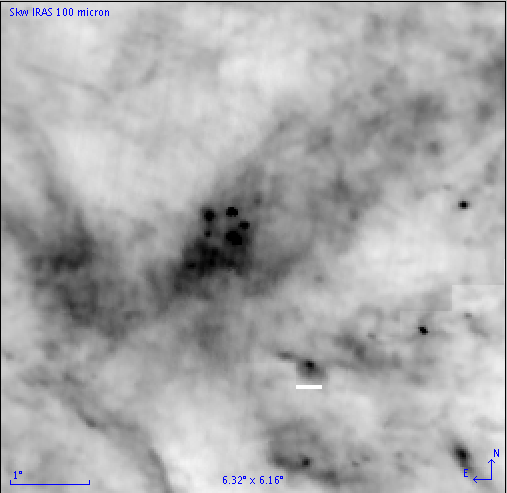
The radio map below shows a closeup of a tiny portion of one of these bright spots. You can see that it is actually composed of several very dense cores of gas.
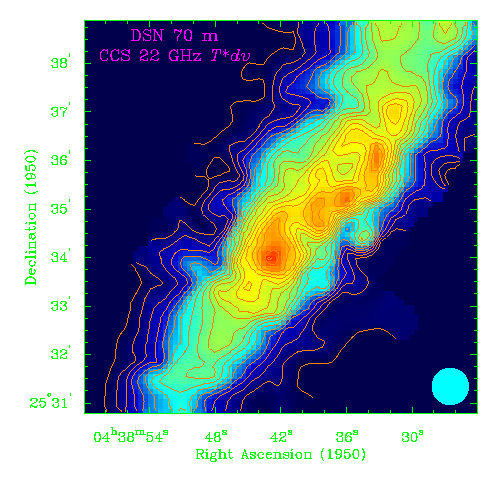
One can also see several compact cores in this optical picture of the Eagle Nebula.

There appear to be two different kinds of these dense cores, small ones and big ones. Some molecular clouds -- such as Taurus -- contain only small cores, which produce stars of relatively low mass (not much more massive than the Sun). Other clouds -- such as the one in the Eagle Nebula -- are filled with much larger cores, which give rise to stars of both low mass and high mass. As a general rule, clouds producing high-mass stars are much more violent places: the gas within them swirls and churns in a turbulent manner, at speeds of several miles per second. Regions forming only low-mass stars, on the other hand, are relatively calm. What makes a cloud produce only low-mass stars, or a mix of high-mass and low-mass stars? We don't know.
Table of core properties
low-mass cores high-mass cores
--------------------------------------------------------------------
Temperature (K) 10 50 - 100
density (per cm^3) >= 10,000 >= 300,000
total mass (M solar) 1 - 100 2000 - 5000
diameter (pc) 0.2 - 0.6 0.4 - 1.7
stars within usually one usually many
--------------------------------------------------------------------
Why do stars form only inside these dense cores within molecular clouds? To answer this question, we must consider the two major factors acting upon a clump of gas in space:
In order for a clump of gas to collapse into a star, the gravitational force pulling inwards must exceed the gas pressure pushing outwards. This requires a high density of material, to produce a strong gravitational force, and very low temperatures, to yield a small gas pressure. Ordinary clouds of gas in the interstellar medium absorb light from nearby stars, which heats them up, raising their internal pressure and preventing them from collapsing. Molecular clouds, however, are so big and so dense that their outer layers completely block the light from surrounding stars. Deep inside them, temperatures drop so low that the gas pressure becomes very weak. If a small region inside a molecular cloud becomes a little denser than average, the gravitational force exceeds the gas pressure and begins to pull the cloud inwards on itself.
The cores within molecular clouds are regions where gravitational collapse has begun. Once it has started, the process feeds on itself: as the cloud shrinks, it becomes denser ... which increases the gravitational force pulling it inwards ... which causes it to shrink some more ... which increases its density even more ... and so on.

We call this a "runaway process." In regions of high-mass star formation, a collapsing core fragments into many pieces, each of which continues to collapse on its own. The collapse will continue until SOMETHING raises the temperature of the gas enough that the gas pressure balances the gravitational force.
One might think that the gravitational collapse of a dense cloud of gas would be a gentle process; after all, the gas is so cold that the atoms within are moving very slowly. Moreover, the average density of the core is still far, far lower than the density of the air you are breathing. Very cold, very tenuous gas -- it sounds like a recipe for a placid, humdrum, gradual shrinking ....
But take a look at this collapsing cloud, known as HH 46/47. In the optical, we see a little shaft sticking out of the hidden center of the dark cloud:
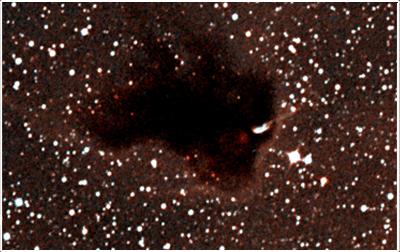
The Spitzer Space Telescope takes pictures at infrared wavelengths, which can penetrate the dusty outer regions of the cloud. This false-color mosaic reveals what's really happening:
Aha! At the center of this cloud is a young protostar. And shooting outwards from the forming protostar are a pair of jets of material. This isn't the only protostar which has jets, either:
Some of this makes sense: we DO understand why a roughly spherical cloud of gas and dust collapses into a flattened disk of material around a central protostar.
But we do NOT yet understand exactly why some of the material should be shot outwards into space along the rotational axis of the disk. And when I write, "shot," I mean "SHOT!"
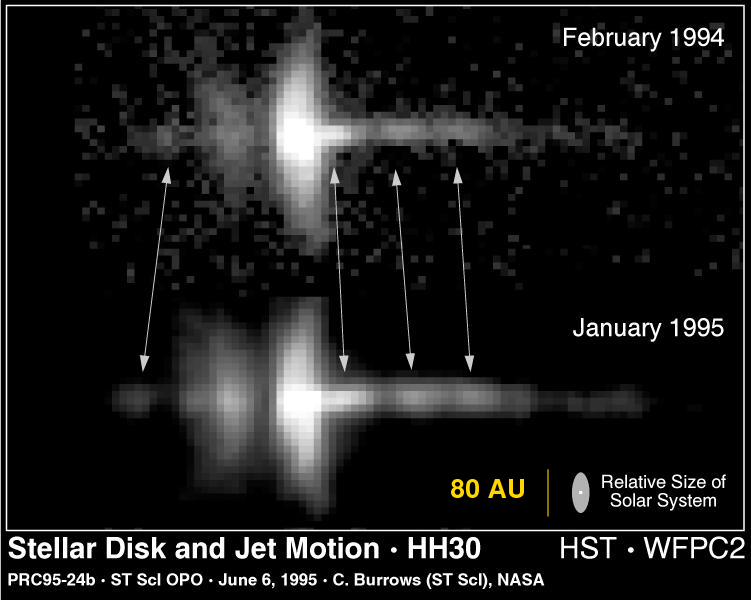
Q: The inset in the figure above shows the
solar system. Assume that the little oval
is about 80 AU in diameter. Recall that
1 AU = 150 million km.
Look at the blob of material to the left
of the main disk. Estimate its velocity in
km/sec. Compare it to a speeding bullet,
which moves at less than 1 km/sec.
The Orion Nebula is a beautiful mixture of stars, gas, and dust, bright enough to see with the naked eye. Because it is the closest region of high-mass star formation (only about 450 parsecs from Earth), astronomers have observed it extensively with telescopes covering the electromagnetic spectrum from the radio spectrum to the X-ray. The entire complex we see is only a portion of a giant cloud called Orion Molecular Cloud 1, or OMC-1 for short.
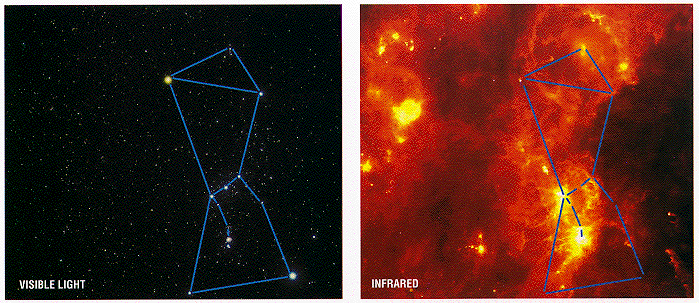
One the near side of OMC-1 is a cluster of about 3500 young stars. We can only see a few hundred with optical telescopes, because the dense gas and dust blocks visible light from those within the cloud. If we observe at longer wavelengths, with an infrared telescope, we can see through much of the dust to the stars inside:
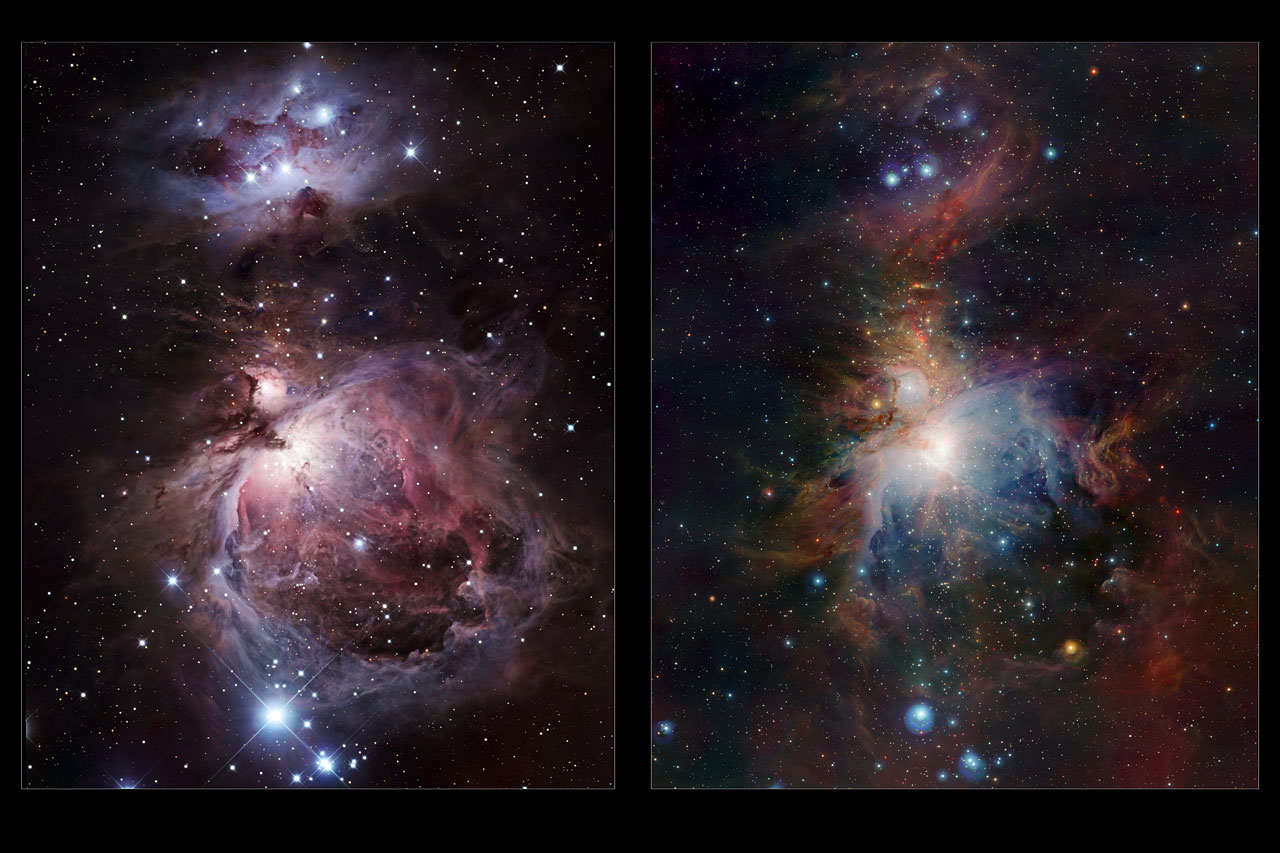
Images of Orion Nebula in optical (left) and near-infrared (right)
courtesy of ESO/J. Emerson/VISTA & R. Gendler
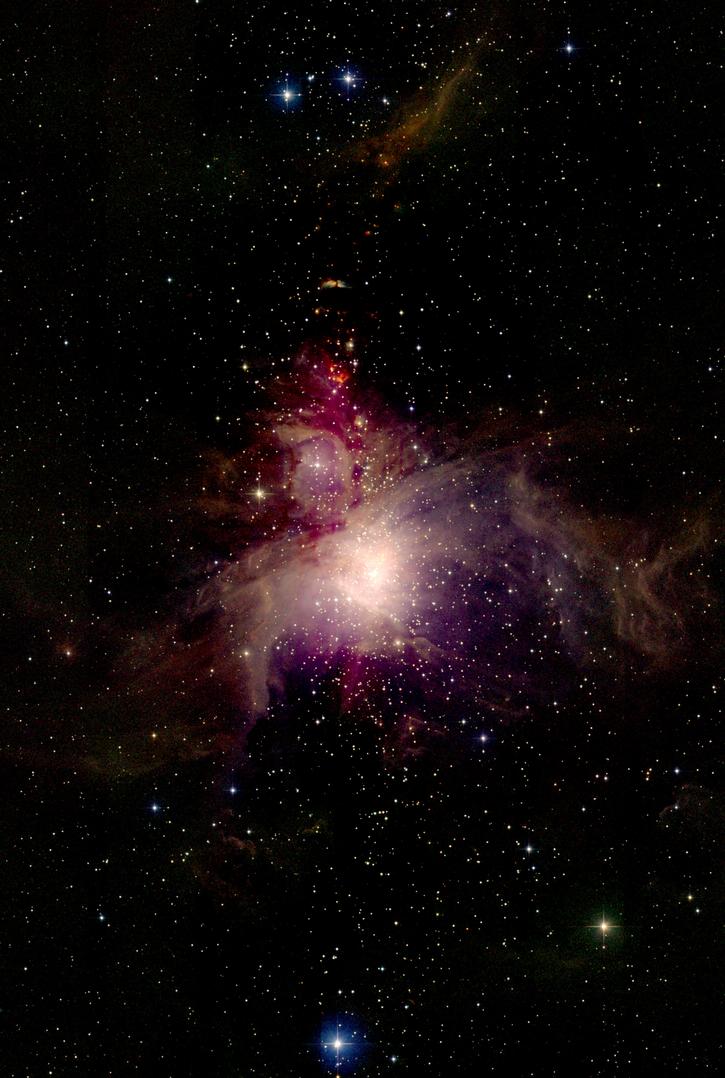
Image of Orion Nebula in near-infrared from 2MASS courtesy
of
2MASS Atlas Image Gallery
Most of these stars are smaller and less massive than the Sun, but a few are much more massive. At the center of the visible Nebula is a quartet of massive stars called "The Trapezium".
The biggest and brightest of these four, a star called "theta-1 Ori C," has a mass about thirty times that of our Sun, and a temperature about 40,000 K.
Q: Where does theta-1 Ori C fall on
the HR diagram?
If you look closely at the picture of the Trapezium, you might notice a few funny-looking objects which look sort of like tadpoles. Images taken by radio telescopes and the Hubble Space Telescope show roughly 150 elongated objects.

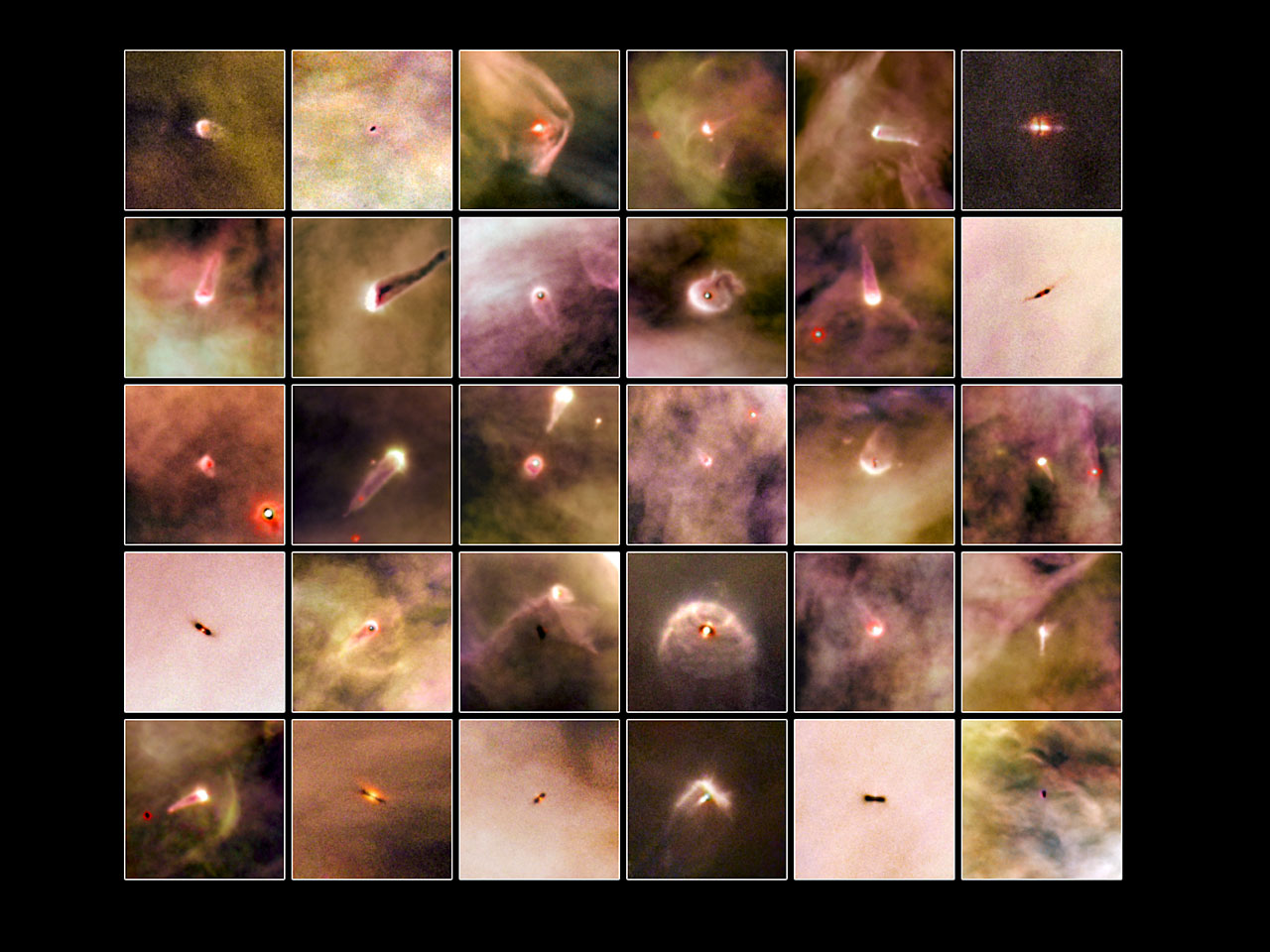
Images courtesy of
NASA, ESA and L. Ricci (ESO)
We believe that these are examples of the last phase in a new star's birth. After a core collapses to form a protostar with disk and jets, the protostar gradually heats up the remaining gas and dust and blows most of it away into space. What remains are called protoplanetary disks, or proplyds for short. They are somewhat larger than our own planetary system: they may extend 100-500 AU from their central stars, compared to 40 AU for Pluto. A few of the proplyds still show evidence for jets of material. Over the next few hundred thousand years, these disks of gas will disappear: most if the material, heated both by the central object and the Trapezium stars, will evaporate into the general nebulosity, but some of the gas may form planets.
 Copyright © Michael Richmond.
This work is licensed under a Creative Commons License.
Copyright © Michael Richmond.
This work is licensed under a Creative Commons License.